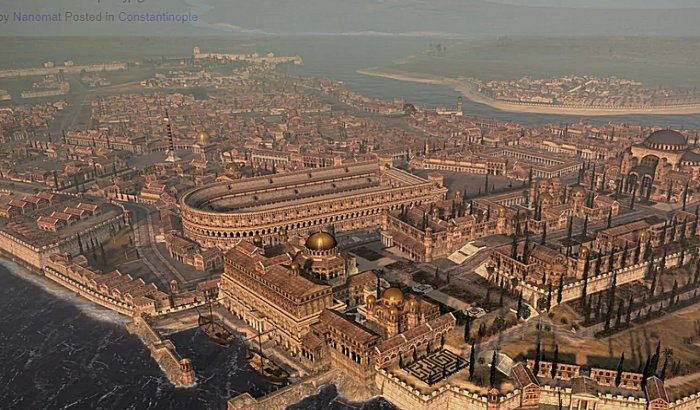Why Was Constantinople Called New Rome?
A. Sutherland - AncientPages.com - Constantinople became a new Rome, and the Emperor Constantine the Great celebrated the inauguration of his new capital city, and the name of the town originates from his name.
In 330 AD, he split the Roman Empire into two parts: Eastern and Western, and the western half centered in Rome while the eastern half centered in Constantinople (City of Constantine).
![Map of Constantinople (1422) by Florentine cartographer Cristoforo Buondelmonti[39] is the oldest surviving map of the city, and the only one that predates the Turkish conquest in 1453.](https://www.ancientpages.com/wp-content/uploads/2020/03/constantinople14.jpg) Map of Constantinople (1422) by Florentine cartographer Cristoforo Buondelmonti is the oldest surviving map of the city and the only one that predates the Turkish conquest in 1453. Source
Map of Constantinople (1422) by Florentine cartographer Cristoforo Buondelmonti is the oldest surviving map of the city and the only one that predates the Turkish conquest in 1453. Source
After restoring the unity of the Empire, Constantine the Great introduced many governmental reforms and increased financial resources for the Christian church.
Then, he identified the site of Byzantium - a small Greek port - as the new center of the Empire and the seat of government, officially known as Nova Roma ('New Rome').
Rome, which had been the capital for over a thousand years, was too far from the frontiers of the Empire, and it might have seemed unimaginable to propose that ancient Rome be moved to another location.
Constantine's dedication of the new city was most probably the most significant moment of his reign. The new capital had a perfect strategic location; it was standing on a piece of land projecting into the Bosphorus, the narrow strait of water dividing two continents: Europe from Asia.
Constantinople could control the major trade routes between these two continents, as well as the passage from the Black Sea to the Mediterranean.
New Coins Struck And Greek And Roman Art Moved To 'Second Rome'
The 'New Rome' (Nova Roma) was built over six years and inaugurated on May 11, 330, and new coins were struck by Constantine I to commemorate the founding of Constantinople.
In many ways, the new city was an almost exact copy of the old and famous eternal city of Rome. Like Rome on the Tiber River, it was also located on seven hills and divided into fourteen administrative districts.
Coin struck by Emperor Constantine I to commemorate the founding of the ‘second Rome.’ Source
However, it was still much to do preparing the new capital's interior. Buildings began to appear in great haste, and Constantine ordered many marbles, columns, and tiles to be transported from Roman temples to the new capital. The best works of Greek and Roman art were used for decorations of streets and squares.
It was essential to give the new city the most impressive look possible. After all, his 'New Rome' was beginning its life as an imperial metropolis.
Many Similarities And One Significant Difference Between Two Rome Cities
The main difference between these two cities was that Constantinople was a Christian city with numerous basilicas and churches. From the beginning, it symbolized the break with Rome's pagan past.
The emperor stimulated private building by promising householders gifts of land from Asiana and Pontica – two of the four major administrative divisions of the Eastern Empire.
On May 18, 332, he announced that, as in Rome, free distributions of food would be made to the citizens, and thus, he encouraged settlement in the city.
Yet, at first, the Empire's new Rome did not have all the dignities of old Rome. It possessed its senate, a proconsul, but no praetors, tribunes, or quaestors authorized to investigate and handle murders.
There was also a lack of several other principal offices responsible for the city's temples, sewers, monuments, aqueducts, and other public works. Soon, however, the 'second Rome' grew prominent, wealthy, and densely populated.
For 1,000 years, under the Byzantine emperors, it was the intellectual, religious, and commercial center of the Greek-speaking world.
Today, Constantinople is Istanbul, the most populous city in Turkey and the country's economic, cultural and historic center, but its old name is still remembered.
Written by – A. Sutherland - AncientPages.com Senior Staff Writer
Copyright © AncientPages.com All rights reserved. This material may not be published, broadcast, rewritten or redistributed in whole or part without the express written permission of AncientPages.com
Expand for referencesReferences:
Norman F. Cantor, Civilization of the Middle Ages
Stephen Turnbull S. and Dennis Peter, The Walls of Constantinople AD 324–1453
More From Ancient Pages
-
 Hyperborea Or Atlantis Ruins – Underground Secrets Of The Sacred Lake On The Arctic Circle
Civilizations | Nov 17, 2014
Hyperborea Or Atlantis Ruins – Underground Secrets Of The Sacred Lake On The Arctic Circle
Civilizations | Nov 17, 2014 -
 Horses In Florida Did Not Travel Far Distances – New Study Suggests
Archaeology | Jan 3, 2019
Horses In Florida Did Not Travel Far Distances – New Study Suggests
Archaeology | Jan 3, 2019 -
 Cyclops – First Generation Of Giants Who Were Prisoners Of Tartarus
Featured Stories | Mar 21, 2018
Cyclops – First Generation Of Giants Who Were Prisoners Of Tartarus
Featured Stories | Mar 21, 2018 -
 Chankillo: A 2300-Year-Old Solar Observatory in Peru
Civilizations | Sep 2, 2015
Chankillo: A 2300-Year-Old Solar Observatory in Peru
Civilizations | Sep 2, 2015 -
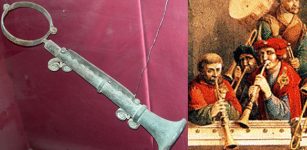 What Was The Medieval Shame Flute?
Ancient History Facts | Jan 27, 2020
What Was The Medieval Shame Flute?
Ancient History Facts | Jan 27, 2020 -
 Enigmatic Ancient City Where People Experience Telepathy And Higher Level Of Consciousness
Ancient Mysteries | Oct 10, 2018
Enigmatic Ancient City Where People Experience Telepathy And Higher Level Of Consciousness
Ancient Mysteries | Oct 10, 2018 -
 On This Day In History: National Hero Paul Revere Warns Of The British Coming – On Apr 18, 1775
News | Apr 18, 2017
On This Day In History: National Hero Paul Revere Warns Of The British Coming – On Apr 18, 1775
News | Apr 18, 2017 -
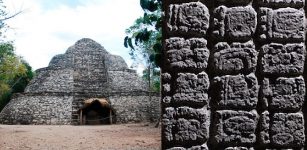 INAH Researchers Deciphered Hieroglyphs And Identified 14 Maya Rulers In Ancient City Of Cobá, Mexico
Archaeology | Jul 29, 2020
INAH Researchers Deciphered Hieroglyphs And Identified 14 Maya Rulers In Ancient City Of Cobá, Mexico
Archaeology | Jul 29, 2020 -
 Mysterious Hyksos People Rose To Power In Ancient Egypt Through Marriage And Not Invasion – Researchers Say
Archaeology | Apr 17, 2019
Mysterious Hyksos People Rose To Power In Ancient Egypt Through Marriage And Not Invasion – Researchers Say
Archaeology | Apr 17, 2019 -
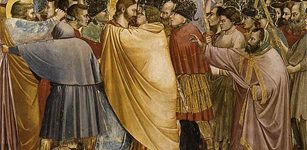 Judas: A Famous Traitor Or A Hero?
Biblical Mysteries | Oct 16, 2017
Judas: A Famous Traitor Or A Hero?
Biblical Mysteries | Oct 16, 2017 -
 Birth Of Good And Evil In Iroquois Beliefs
Featured Stories | Sep 23, 2019
Birth Of Good And Evil In Iroquois Beliefs
Featured Stories | Sep 23, 2019 -
 Dracula: Cruel, Ruthless And Bloodthirsty Ruler But Not A Vampire
Featured Stories | Sep 12, 2023
Dracula: Cruel, Ruthless And Bloodthirsty Ruler But Not A Vampire
Featured Stories | Sep 12, 2023 -
 Ancient Scandinavians Never Spoke Of Themselves As Vikings – Here Is Why
Ancient History Facts | Mar 15, 2021
Ancient Scandinavians Never Spoke Of Themselves As Vikings – Here Is Why
Ancient History Facts | Mar 15, 2021 -
 On This Day In History: Casanova – Famous Seducer And Adventurer Dies In A Castle In Bohemia – On June 4, 1798
News | Jun 4, 2016
On This Day In History: Casanova – Famous Seducer And Adventurer Dies In A Castle In Bohemia – On June 4, 1798
News | Jun 4, 2016 -
 Peculiar Ancient Stone Disk Could Be World’s Oldest Celestial Map
Archaeology | Jan 3, 2024
Peculiar Ancient Stone Disk Could Be World’s Oldest Celestial Map
Archaeology | Jan 3, 2024 -
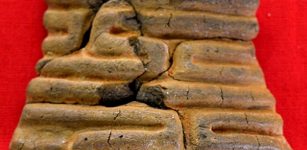 3,000-Year-Old Piece Of Pottery Unearthed On Okinawa Island, Japan
Archaeology | Feb 21, 2017
3,000-Year-Old Piece Of Pottery Unearthed On Okinawa Island, Japan
Archaeology | Feb 21, 2017 -
 Does This Cathedral Offer Evidence Our Calendar Is ‘Missing’ 297 Years?
Featured Stories | May 6, 2022
Does This Cathedral Offer Evidence Our Calendar Is ‘Missing’ 297 Years?
Featured Stories | May 6, 2022 -
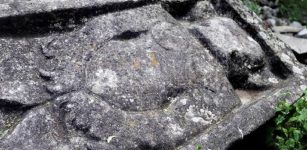 Pre-Hispanic Carved Stone Monuments Discovered On A Mountaintop In Puebla, Mexico
Archaeology | Jul 25, 2020
Pre-Hispanic Carved Stone Monuments Discovered On A Mountaintop In Puebla, Mexico
Archaeology | Jul 25, 2020 -
 Unexplained Historical Mass Disappearances – Lost Without Trace – Part 1
Featured Stories | May 31, 2019
Unexplained Historical Mass Disappearances – Lost Without Trace – Part 1
Featured Stories | May 31, 2019 -
 500-Year-Old Transylvanian Diaries Reveal How The Little Ice Age Transformed Life And Death In The Region
Archaeology | Feb 12, 2025
500-Year-Old Transylvanian Diaries Reveal How The Little Ice Age Transformed Life And Death In The Region
Archaeology | Feb 12, 2025


